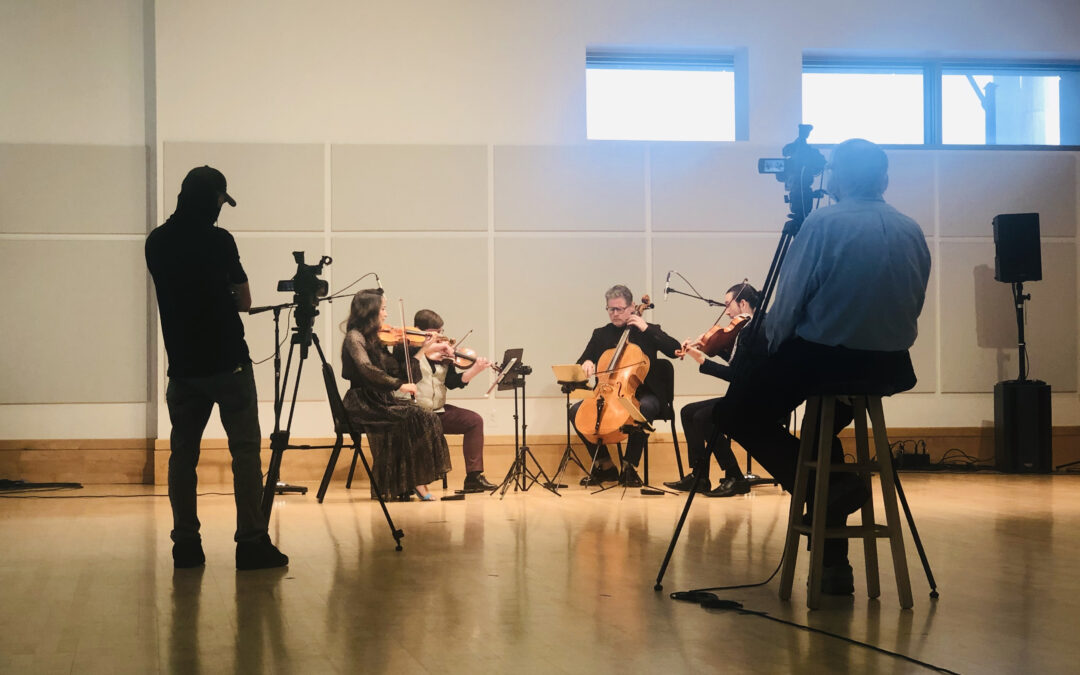(Catalyst Quartet’s virtual matinee recording session at Virginia Arts Festival headquarters)
By Montague Gammon III
Even the worst plague the world has seen in a hundred years cannot keep the Virginia Arts Festival from bringing world class arts events to students here.
COVID-91 tossed the Festival’s annual live educational outreach programs right out the empty classroom window.
The demand for pandemic proof events put the Festival in an “all new world,”’ said Rob Cross, Festival Executive Director and Perry Artistic Director.
“It was really important to us,” Cross commented in a telephone chat, “to find a way to bring some content to our partners at a high level.” Otherwise, he pointed out, students would miss out on uniquely high quality arts exposure for a full year.
He credits Christine Foust, Director of Education and Community Outreach, with helming a program that is rich in “artistic quality and engaging for the students,” geared to “helping teachers create context” so that online events would not be “just another hour in front of the computer.”
“Our mission,” said Foust, “is to make educational events as close to normal, to what we do.”
(What they did last school year reached 36,882 regional K-12 students, in 171 schools across 21 cities and counties.)
Beyond replacing those live events with “45-minute videotaped lecture-demonstrations” of three musical ensembles and a Norfolk linked Broadway duo this Fall, VAF added “artist masterclasses and live Zoom discussions … to help teachers continue to engage their students after the performance has ended,” press releases note.
On this Fall’s roster, which will be available throughout the school year, are “virtual residencies” by The Seraph Brass, the Catalyst Quartet, the Akropolis Reed Quintet and the pairing of Norfolk native Rob Fisher – pianist, conductor, music director, arranger and more on Broadway and Off, on recordings, symphony podiums and pianos, and with everyone from Renée Fleming to Garrison Keilor – with soprano Meredith Lustig, who was Va Opera’s Eurydice a few years back, in the midst of her international career in opera, musical theater, and Shakespearean cabaret.
The Seraph Brass is an all female group that usually numbers five or six, whose performances of new works and classic pieces have sparked comments like “high caliber…staggering…a high energy roller coaster of a ride.”
The NY Times called the Carnegie Hall debut of the Catalyst Quartet “invariably energetic and finely burnished.” All four are high achieving veterans of the national Sphinx Competition for young Black and Latinx classical string players.
Rob Cross calls “the playing” of the Akropolis Reed Quintet “really amazing.” Published comments about this group, which is especially devoted to “provid[ing] greater arts access to audiences beyond the concert stage,” include phrases such as “super talented..innovative, youthful and full of enthusiasm,” and have cited their “imagination, infallible musicality, and huge vitality.”
The Festival’s acclaimed Rhythm Project, whose steel drum programs work with students from elementary school up to high school, is still going social distanced strong.
Fall programs will be available throughout the school year; expanded programs in the Winter and Spring will bring in story teller Charlotte Blake Alston, who specializes traditional and contemporary stories from African and African American oral and cultural traditions, a couple of dance companies (details to be announced), along with the Staunton, Virginia based American Shakespeare Center, whose productions of Twelfth Night and Othello have already been pioneering theatrical art in the pandemic prompted venues of live streamed and on demand viewing.
“They have really managed this pivot” to COVID conscious theater, Foust notes.
“We want students to know art exists and to see possibilities,” adds Foust, whose background before coming to the Festival staff 10 years ago involved serving in AmeriCorps for a year, running an after-school tutoring program for children in a low-income housing development.
Arts in education, she points out, is meant for every student, offering a way of “learning about the world around you.”
“There’s something for everybody in the arts.”




